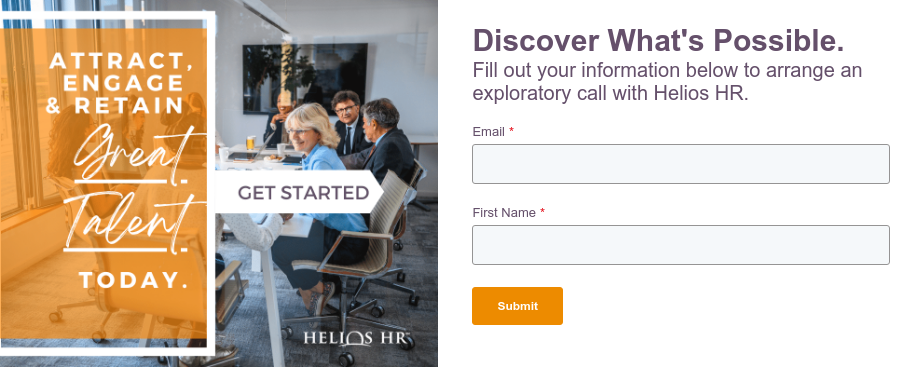By: Helios on August 9th, 2024
The 4 P's of an HR Brand: People, Pay, Process & Promotion
Communication | Best Practices | Employee Relations | Talent Acquisition
Every company lives and dies on its reputation. This is why businesses invest so heavily in marketing, working hard to grow their reputation and build brand awareness.
Marketing professionals develop reputations by focusing on the four things that customers care about the most: Product, Place, Price, and Promotion. If you get the 4 P's right, you'll start to develop a positive reputation among customers.
But what about your reputation among employees?
We often talk about the Employer Brand, which is an important part of attracting top talent. But it's also important to think about your HR Brand, which defines the overall employee experience.
Understanding the HR Brand
HR brands can play an important in attracting, engaging, developing, and retaining a best-in-class workforce. A strong HR brand has four main components:
- People
- Pay
- Process
- Promotion
A well-executed HR brand can yield significant benefits for your organization:
- Improved talent acquisition: A strong employer brand can reduce cost-per-hire and time-to-fill for open positions
- Enhanced employee engagement: When employees connect with your brand, they're more likely to be engaged and productive
- Increased retention: A positive employee experience leads to higher retention rates and reduced turnover costs
- Better business outcomes: Engaged employees and a positive workplace culture often translate to improved customer satisfaction and financial performance
Southwest Airlines serves as an excellent example of successful HR branding. The company has built a strong culture-driven brand that permeates all aspects of its HR functions, from recruitment to performance management. This approach has resulted in turnover rates three times lower than the industry average and significantly higher earnings.
Southwest's commitment to its HR brand has earned it numerous accolades, including a spot on Fortune's America's Top Ten Admired Companies list.
The 4 P's of an HR brand
Let's take a look at each of the 4 P's in more detail:
1. People
Your team members are the living, breathing representation of your HR brand. They aren't just employees; they're brand ambassadors who experience your culture firsthand and share their experiences with others.
To leverage the "People" aspect of your HR brand:
- Foster a positive and inclusive work environment
- Invest in employee development and growth opportunities
- Encourage open communication and feedback
- Recognize and reward employee contributions
- Promote work-life balance and employee well-being
2. Pay
While competitive compensation is crucial, the "Pay" aspect of your HR brand encompasses more than just salary. It includes your entire Total Rewards package:
- Develop a fair and transparent compensation structure
- Offer comprehensive benefits that cater to diverse employee needs
- Implement performance-based incentives and bonuses
- Provide non-monetary perks that enhance the employee experience
- Regularly review and adjust your offerings to stay competitive in the market
3. Process
The "Process" component of your HR brand relates to how efficiently and effectively you manage various HR functions. This includes:
- Designing a smooth and engaging recruitment process
- Creating a comprehensive onboarding program
- Implementing fair and consistent performance management systems
- Developing clear career progression paths
- Utilizing technology to streamline HR processes and improve the employee experience
4. Promotion
The final P, "Promotion," is about effectively communicating your HR brand both internally and externally:
- Develop a clear and compelling brand promise
- Leverage social media platforms like LinkedIn to showcase your company culture
- Encourage employee advocacy through testimonials and referral programs
- Participate in industry events and job fairs to increase brand visibility
- Consistently communicate your brand message across all touchpoints
Building Your HR Brand: A Step-by-Step Approach
An HR brand is more than just a logo or a catchy slogan. It's the embodiment of your organization's culture, company values, and employee experience. A strong HR brand communicates what it's like to work for your company and sets expectations for both current employees and job seekers. When done right, it can become a powerful tool for talent acquisition and retention, ultimately driving business success.
1. Define Your Identity
Start by clearly articulating your HR department's value proposition. What unique benefits do you offer to employees? How does your organization stand out from competitors? Conduct surveys and focus groups to understand the current perception of your HR brand and identify gaps between the current and ideal employee experience.
2. Make Your Mark
Once you've defined your desired brand identity, it's time to take action. For each of the four P's:- Identify current practices that are helping or hindering your brand perception
- Develop an action plan outlining what you need to start doing, stop doing, and continue doing
- Consider all aspects of the employee experience, from recruitment to retirement
3. Launch and Refine Your Brand
Implementing your HR brand is an ongoing process that requires consistency and commitment. Some key steps include:- Train all Human Resources staff and leadership on the new brand message and expectations
- Update all HR materials, communications, and touchpoints to reflect the new brand
- Regularly solicit feedback from employees and candidates to gauge brand perception
Conclusion: The power of HR branding
It's crucial to track relevant metrics to measure the success of your HR branding initiatives. These may include employee satisfaction scores, retention rates, quality of hire, and employer rankings. By consistently monitoring these metrics, you can ensure that your efforts are truly positioning your organization as an employer of choice and attracting high-quality talent.
Need some help developing your HR brand? Schedule a call with a Helios HR expert and let's talk about how you can attract, retain and engage the best talent.





